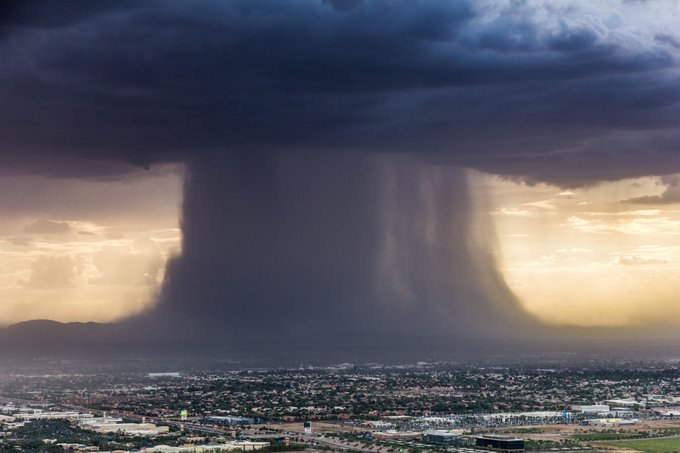

- DollyLongstaff
- Member
 Offline
Offline 
- Registered: 8/10/2015
- Posts: 5,899
A Miracle Has Happened
Rhoda, the over sharer from PA who enjoys having wonton sex with her husband Carl in other peoples' homes, has become a Climate Change/Global Warming believer.
Evidence shows that the sky is coming down on our heads—the watery part of it, anyway, in larger and larger cascades. In part, it’s our own fault.
The past two months have seen some doozies just in the U.S. The Empire State Building was struck by lightning twice on Monday during a storm that brought an inch of rain down in what felt like a single sheet.
At least 23 people died in West Virginia flooding last month. At its peak on June 23, more than 8 inches to 10 inches fell within half a day—a once-every-1,000 years rain storm. Storms in May and early June dropped five times as much rain as normal near Houston, seriously challenging the definition of normal. More than a dozen people died. It was the city's fifth major flood in just over a year. (Rainfall is trending higher nationally, though paving over much of Texas probably doesn't help.)
The most dramatic recent image came from Bruce Haffner, a Phoenix TV helicopter pilot, who snapped what looks very much like a 20-megaton hydrogen bomb exploding. This is informally known as a “rain bomb":
“Rain bomb” is an informal name given to what meteorologists know as a “wet microburst.” They are supposed to happen rarely; conditions must be just right. A thunderstorm runs into a dry patch of air that sucks some moisture away. The air underneath the storm cloud cools, making it more dense than the air around it. The cooler air begins to drop into even warmer air and then accelerates. When the faucet really flips on, air can blast out of the sky at more than 115 miles per hour. It deflects off the ground and pushes winds outward, at or near tornado strength. The Phoenix event above was actually a “macroburst,” with a radar footprint wider than about 2.5 miles, said Amber Sullins, chief meteorologist at ABC-15 News.
Scientists understand the mechanics of small-scale phenomena such as rain bombs, tornadoes, and severe thunderstorms. The past few years have seen modest improvements in projections of how these storms might behave in a changing atmosphere, region-by-region.
Last edited by DollyLongstaff (7/30/2016 8:11 am)
Back with a vengeance possums!
- DollyLongstaff
- Member
 Offline
Offline 
- Registered: 8/10/2015
- Posts: 5,899
Re: A Miracle Has Happened
“The research showing rain events for us being less frequent but more intense, due to climate change, seems to be our new reality,” Sullins said.
What’s known with much greater confidence by climatologists is that storms should continue to intensify. There's little question that by stockpiling water vapor, the atmosphere is building a worldwide arsenal of “rain bombs”—or, if you like, wet microbursts, macrobursts, or just your typical, Noah-scale deluges. And unlike, say, the study of climate change and its relationship to war, why the sky keeps falling is clearer:
- Human activity has increased the amount of carbon dioxide in the air by more than 40 percent above pre-industrial levels.
Last edited by DollyLongstaff (7/30/2016 8:08 am)
Back with a vengeance possums!
- •
- DollyLongstaff
- Member
 Offline
Offline 
- Registered: 8/10/2015
- Posts: 5,899
Re: A Miracle Has Happened
Bloomberg Carbon Clock: Measuring Carbon Dioxide that Causes Global Warming
- The CO2 and other climate pollutants trap more heat in the atmosphere.
- A hotter atmosphere holds more water—about 4 percent more for every degree-Fahrenheit rise in average temperature.
- More water vapor and energy in the system mean more intense storms. And lots, and lots, and lots of water.
From 2001 to 2012 (the right-most green bar shown above), once-every-five-year storms occurred 40 percent more often than normal for the U.S., or about every three years. In 2015, these five-year storms happened 80 percent more frequently than expected, according to Ken Kunkel, a scientist with NOAA's National Centers for Environmental Information.
It's not just that the amount of rain is increasing; the amount of extreme rain is increasing. All over the Earth's land masses. The year 2010 had 88 percent more broken records than might have occurred in a stable climate, according to a study last year by German researchers. From 1981 to 2010, 12 percent more record-breaking rainstorms occurred worldwide than would have happened without human influence. “This implies that over the last 30 years, roughly one in ten record-breaking events would not have occurred without climate change,” they wrote.
Scientists can’t say where the next rain bomb may land. They still don't know where lightning will strike next. But it’s clear from wide-ranging research that human activity has weaponized the atmosphere.
Last edited by DollyLongstaff (7/30/2016 8:10 am)
Back with a vengeance possums!
- •
- DollyLongstaff
- Member
 Offline
Offline 
- Registered: 8/10/2015
- Posts: 5,899
Re: A Miracle Has Happened
Question. Will Rho be thrown from the nest for this admission?
Back with a vengeance possums!
- •

 1 of 1
1 of 1